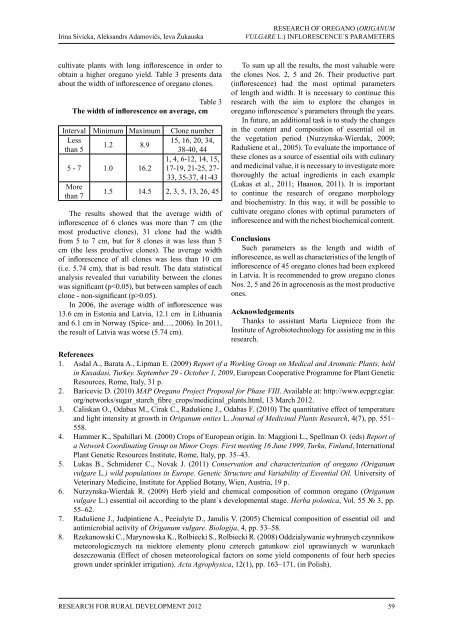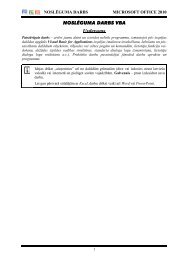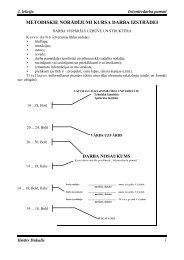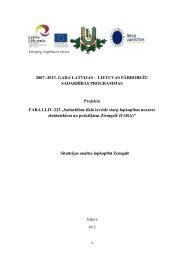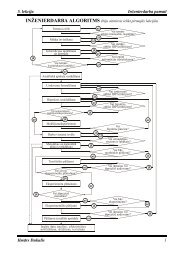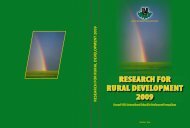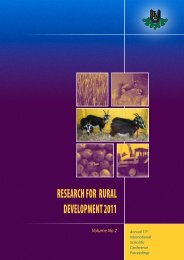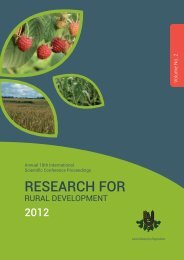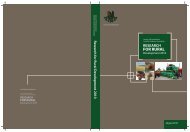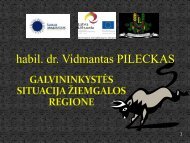LATVIA UNIVERSITY OF AGRICULTURE - Latvijas ...
LATVIA UNIVERSITY OF AGRICULTURE - Latvijas ...
LATVIA UNIVERSITY OF AGRICULTURE - Latvijas ...
- No tags were found...
You also want an ePaper? Increase the reach of your titles
YUMPU automatically turns print PDFs into web optimized ePapers that Google loves.
Irina Sivicka, Aleksandrs Adamovičs, Ieva ŽukauskaRESEARCH <strong>OF</strong> OREGANO (ORIGANUMVULGARE L.) INFLORESCENCE`S PARAMETERScultivate plants with long inflorescence in order toobtain a higher oregano yield. Table 3 presents dataabout the width of inflorescence of oregano clones.Table 3The width of inflorescence on average, cmInterval Minimum Maximum Clone numberLess15, 16, 20, 34,1.2 8.9than 538-40, 441, 4, 6-12, 14, 15,5 - 7 1.0 16.2 17-19, 21-25, 27-33, 35-37, 41-43Morethan 71.5 14.5 2, 3, 5, 13, 26, 45The results showed that the average width ofinflorescence of 6 clones was more than 7 cm (themost productive clones), 31 clone had the widthfrom 5 to 7 cm, but for 8 clones it was less than 5cm (the less productive clones). The average widthof inflorescence of all clones was less than 10 cm(i.e. 5.74 cm), that is bad result. The data statisticalanalysis revealed that variability between the cloneswas significant (p0.05).In 2006, the average width of inflorescence was13.6 cm in Estonia and Latvia, 12.1 cm in Lithuaniaand 6.1 cm in Norway (Spice- and…, 2006). In 2011,the result of Latvia was worse (5.74 cm).To sum up all the results, the most valuable werethe clones Nos. 2, 5 and 26. Their productive part(inflorescence) had the most optimal parametersof length and width. It is necessary to continue thisresearch with the aim to explore the changes inoregano inflorescence`s parameters through the years.In future, an additional task is to study the changesin the content and composition of essential oil inthe vegetation period (Nurzynska-Wierdak, 2009;Radušiene et al., 2005). To evaluate the importance ofthese clones as a source of essential oils with culinaryand medicinal value, it is necessary to investigate morethoroughly the actual ingredients in each example(Lukas et al., 2011; Иванов, 2011). It is importantto continue the research of oregano morphologyand biochemistry. In this way, it will be possible tocultivate oregano clones with optimal parameters ofinflorescence and with the richest biochemical content.ConclusionsSuch parameters as the length and width ofinflorescence, as well as characteristics of the length ofinflorescence of 45 oregano clones had been exploredin Latvia. It is recommended to grow oregano clonesNos. 2, 5 and 26 in agrocenosis as the most productiveones.AcknowledgementsThanks to assistant Marta Liepniece from theInstitute of Agrobiotechnology for assisting me in thisresearch.References1. Asdal A., Barata A., Lipman E. (2009) Report of a Working Group on Medical and Aromatic Plants, heldin Kusadasi, Turkey. September 29 - October 1, 2009, European Cooperative Programme for Plant GeneticResources, Rome, Italy, 31 p.2. Baricevic D. (2010) MAP Oregano Project Proposal for Phase VIII. Available at: http://www.ecpgr.cgiar.org/networks/sugar_starch_fibre_crops/medicinal_plants.html, 13 March 2012.3. Caliskan O., Odabas M., Cirak C., Radušiene J., Odabas F. (2010) The quantitative effect of temperatureand light intensity at growth in Origanum onites L. Journal of Medicinal Plants Research, 4(7), pp. 551–558.4. Hammer K., Spahillari M. (2000) Crops of European origin. In: Maggioni L., Spellman O. (eds) Report ofa Network Coordinating Group on Minor Crops. First meeting 16 June 1999, Turku, Finland, InternationalPlant Genetic Resources Institute, Rome, Italy, pp. 35–43.5. Lukas B., Schmiderer C., Novak J. (2011) Conservation and characterization of oregano (Origanumvulgare L.) wild populations in Europe. Genetic Structure and Variability of Essential Oil. University ofVeterinary Medicine, Institute for Applied Botany, Wien, Austria, 19 p.6. Nurzynska-Wierdak R. (2009) Herb yield and chemical composition of common oregano (Origanumvulgare L.) essential oil according to the plant`s developmental stage. Herba polonica, Vol. 55 № 3, pp.55–62.7. Radušiene J., Judpintiene A., Peeiulyte D., Janulis V. (2005) Chemical composition of essential oil andantimicrobial activity of Origanum vulgare. Biologija, 4, pp. 53–58.8. Rzekanowski C., Marynowska K., Rolbiecki S., Rolbiecki R. (2008) Oddzialywanie wybranych czynnikowmeteorologicznych na niektore elementy plonu czterech gatunkow ziol uprawianych w warunkachdeszczowania (Effect of chosen meteorological factors on some yield components of four herb speciesgrown under sprinkler irrigation). Acta Agrophysica, 12(1), pp. 163–171. (in Polish).Research for Rural Development 201259


